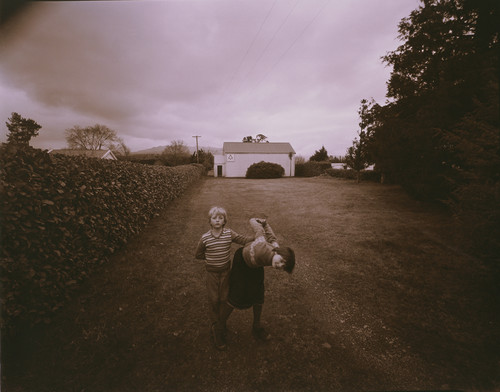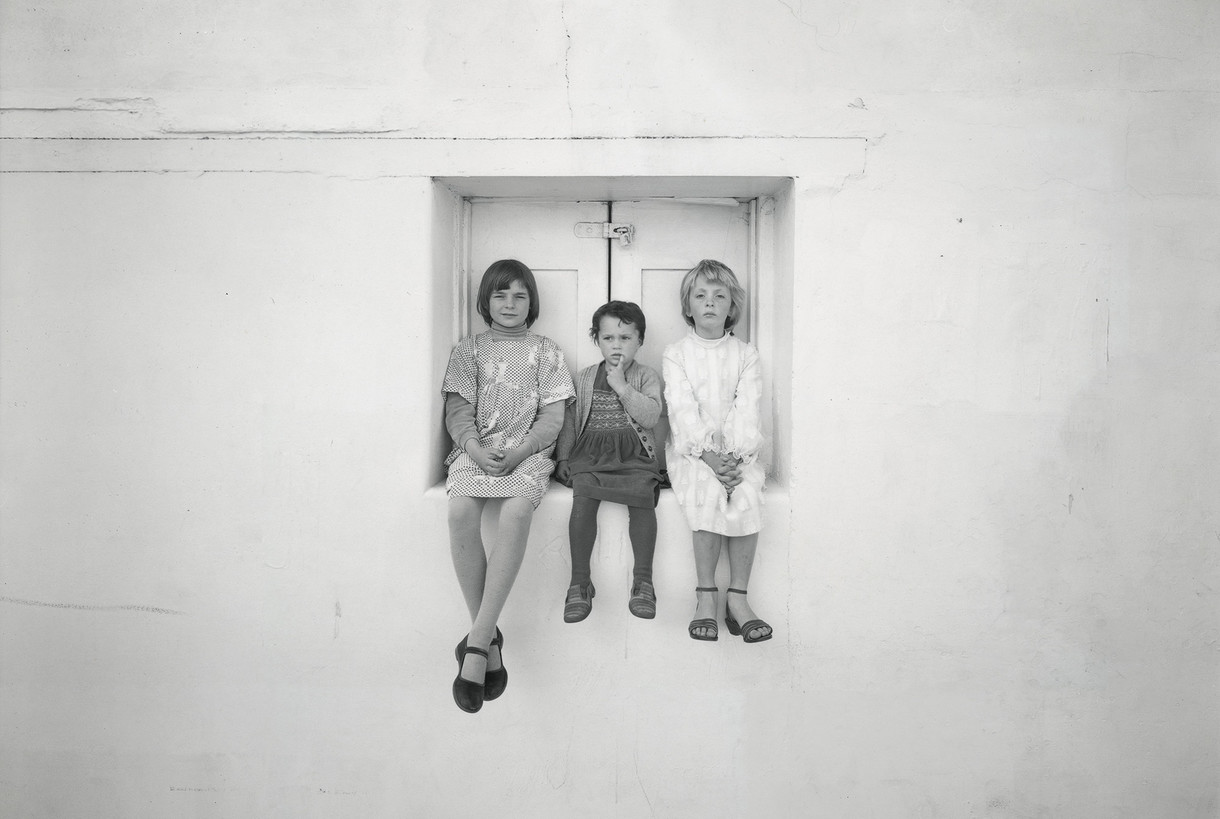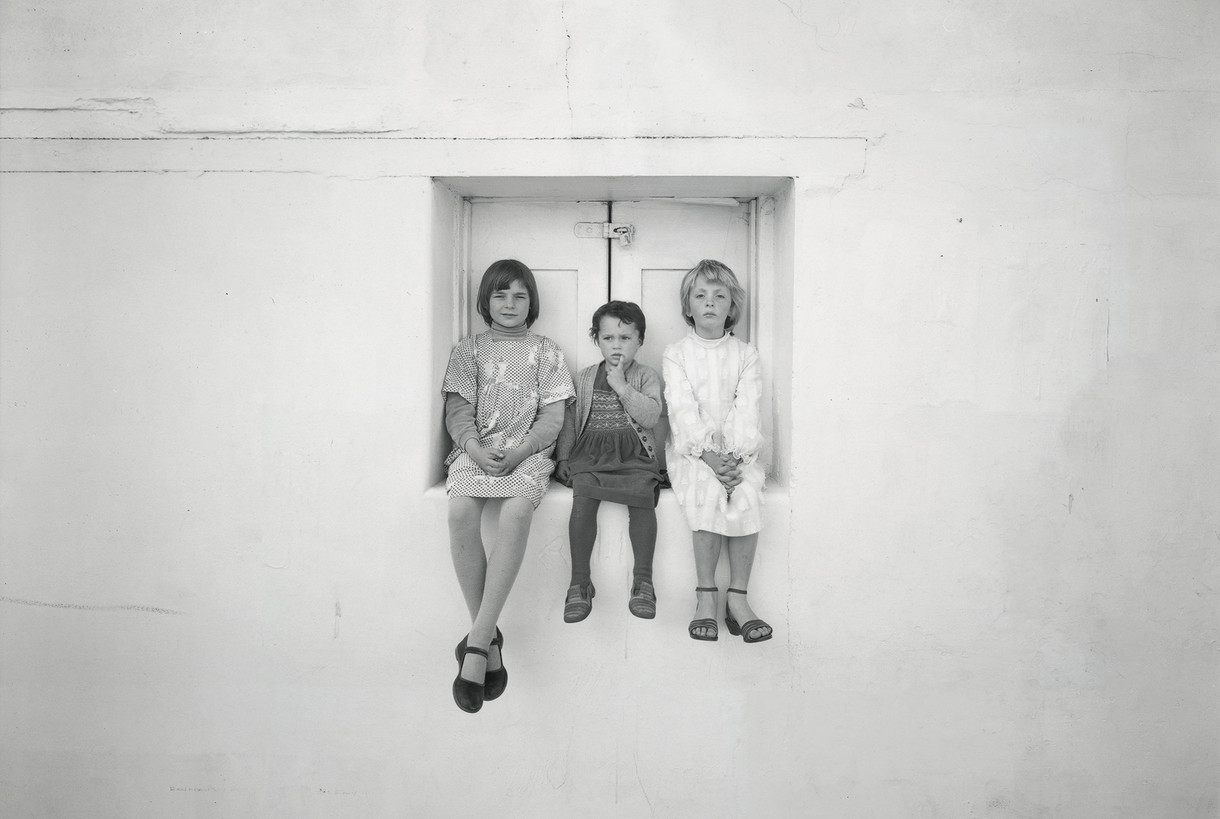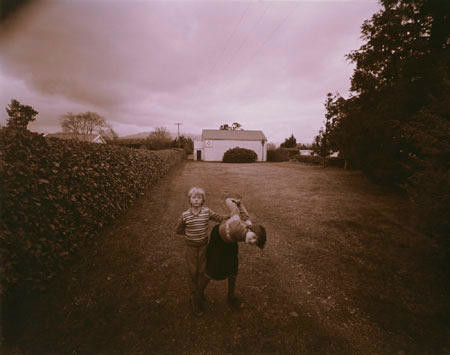B.
Kamala and Charlotte in the grounds of the Lodge, Tawera, Oxford, 1981, by Laurence Aberhart
Collection
This article first appeared in The Press on 9 July 2008
It is adapted from an essay in the book Laurence Aberhart, published by Victoria University Press in partnership with City Gallery, Wellington.

Laurence Aberhart Kamala and Charlotte in the grounds of the Lodge, Tawera, Oxford 1981. Collection of Christchurch Art Gallery Te Puna o Waiwhetū, gifted to the gallery by Laurence Aberhart 1982. Reproduced courtesy of the photographer
To find out how much images mean to you, try this. Imagine a museum filled with your favourite photographs, and then imagine it burning. You are allowed in, but with time to save only one image. Reputation and resale value aren't allowed to play any part in the choice. The photo must mean more to you than its place on the Tote Board of history. The clock is ticking. Which will it be?
The Fire Test starts to lose its fun when you think seriously about all the images you have to leave in flames. But, if forced, I'd exit the building carrying a photograph by Laurence Aberhart from 1981 called Kamala and Charlotte in the Grounds of Lodge Tawera, Oxford. Clearly, there are other images - and other images by Aberhart - that are grander, costlier, more ‘important' or ‘canonical'. But ever since encountering it in the early 1990s in what was then the Robert McDougall Art Gallery, this small dark photo is one I have taken personally - an effect this artist's work seems to have on many of his fans.
The reasons have a lot to do with time, and in particular with the time it was made. I'm roughly the same age as Kamala, Aberhart's oldest daughter, who is about eight in the photo. So the cut of the children's hair, their hand-knits and round-toed sneakers, the mesh of small details that give a period its look - all of this feels familiar. So does the location, which reminds me of the dry-grassed country schools and shelter-belted playgrounds of Canterbury and North Otago. And the subject of the photo recalls any one of the thousands of family snaps in which kids are caught halfway between seriousness and goofing off. Of course, I have my own photos to look back on. But Aberhart's photograph does more than give us something to look back on. It also manages, in some larger sense, to be about the act of looking back.
When Aberhart began making photographs of Lodges like these, he was driven by a fear that they would be bowled, sold or simply left to decay. But Lodge Tawera is still there. You can find it on the road that runs straight through the small North Canterbury town of Oxford. On the summer day my family and I went looking for it two years ago, a shaggy summer hedge all but obscured the street-front sign.
TAWERA MASONIC LODGE
No. 188
(Founded 1922)
Meetings first Tuesday of every month.
Inside the front gate, the Cocksfoot and Yorkshire Fog were in need of a mow, and even at midday in January our shoes were soon soaked. The power line that rides down the middle of Aberhart's photograph was long gone, and there was a new security light screwed to the roof. The cabbage tree had been chopped back and sprung up again three-headed, while the huge central shrub in the photo had been cut right out, revealing a door. The biggest spider web in North Canterbury quivered across the entryway, and the bottom edge of each mock weatherboard glowed with green moss. Up in the big cypress, a bird did something unheard of in 1981 and imitated a cell-phone.
So a lot had changed over the last twenty-five years. And then again not much had changed. But what you noticed above all, standing there in the grounds, was how much of the scene Aberhart himself changed during the twenty seconds it took him to make the photograph. For a start, there is the strange sepia light that pervades the scene and defines Aberhart's world, along with the greys of his gelatin silver prints and the dusty pinks of his platinum prints. (I've heard a friend of Aberhart's recall his initial surprise when he looked through the viewfinder of this photographer cumbersome view camera and saw a world still in colour.) Toning the photograph with gold and selenium, Aberhart creates a light like you sometimes encounter during the ‘magic hour' of dusk, when lowering sun softens shadows, activates the light-sensitive edges of your visual field, and makes every detail look uncannily present.
This darkness thickens in the corners of the print, and gathers in the space under the trees on the right. The kids seem to dip their feet into it. Are they coming into the light, or is shadow moving in on them? Is the moment escaping the photographer, slipping into darkness? Or could we say that he's letting it go - acknowledging the limits of what any one photo can haul into its frame? The lawn in front of Lodge Tawera isn't large, but Aberhart's wide-angle lens draws it out and pushes the Lodge into deep space, the hedge stretched out through the depth of the photo like a big rope holding background to foreground. To see right into this space you have to get very close. You're not a ‘viewer' but a confidant.
Aberhart doesn't spell anything out or overdo the symbolism. He keeps his title bluntly descriptive. But despite that reserve - maybe even because of it - the photograph effortlessly evokes something larger than its immediate subject. The depth of the space, the encroaching darkness, the continuity of tone, the contrast between an old distant institution and two intensely present kids - all of this makes us feel, almost physically, the stretch between past and present.
Time and again when commentators talk about Aberhart, they dwell on his darkest images: the dead-still museum displays, the time-scarred war memorials, the angels keeping watch over unkempt graveyards. There's lots of talk of emptiness, silence, abandonment; the word Gothic comes up constantly. Robert Leonard summed up this perception in the catalogue for Aberhart's 1990 survey exhibition when he wrote that ‘Aberhart's scenes are deserted, empty. The people have gone, leaving only cryptic remains of their culture. His New Zealand is a ghost town.' And it's true, people are frequently absent. Midday in Aberhart country often resembles our midnight - no cars, not a soul about.
But here and there throughout his body of work you come up against these sudden bursts of human presence: his daughters, his son, a shopkeeper in Macau, some wood-carvers in the Hokianga, and even the shadow of the photographer himself falling forward across the scene. Put these faces and figures alongside even his starkest views and another story starts to emerge. We start to picture the lives and stories lived inside and alongside these mute buildings and monuments. Signs of life in the ghost town.
Aberhart recalls filing his Lodge Tawera image and others like it under the loose heading ‘Wired, and in the land of the living'. And ‘liveness' above all is what he seems to value in the children: the vivid way they inhabit the present. It is no coincidence that Charlotte and Kamala inhabit the same foreground space in their photo that stone angels occupy in many others. It's as if the angels have been pushed aside by these staring, vividly present kids. Charlotte mimics the stiffness of a statue, and Kamala topples free - topples into the land of living.
Together they remind us that ‘the past', as William Faulkner put it, is not dead, and not even past.
Justin Paton


